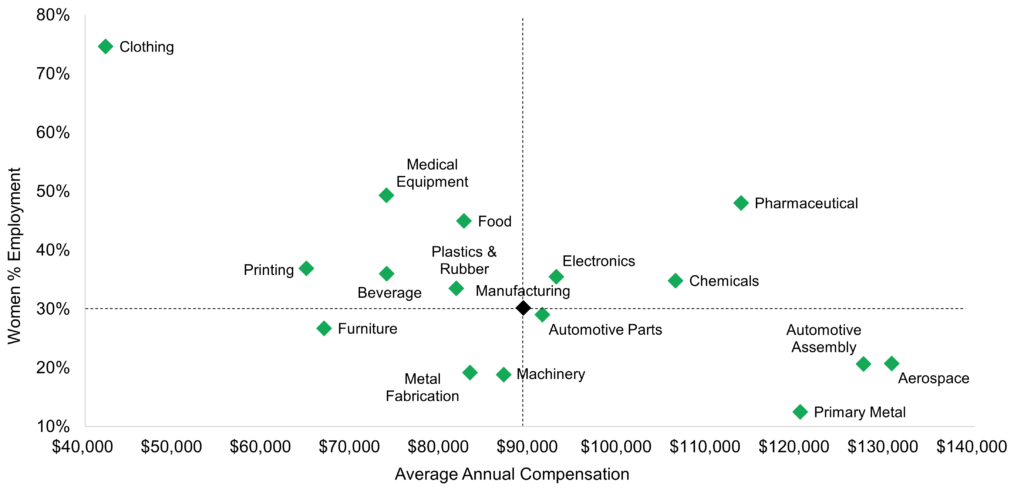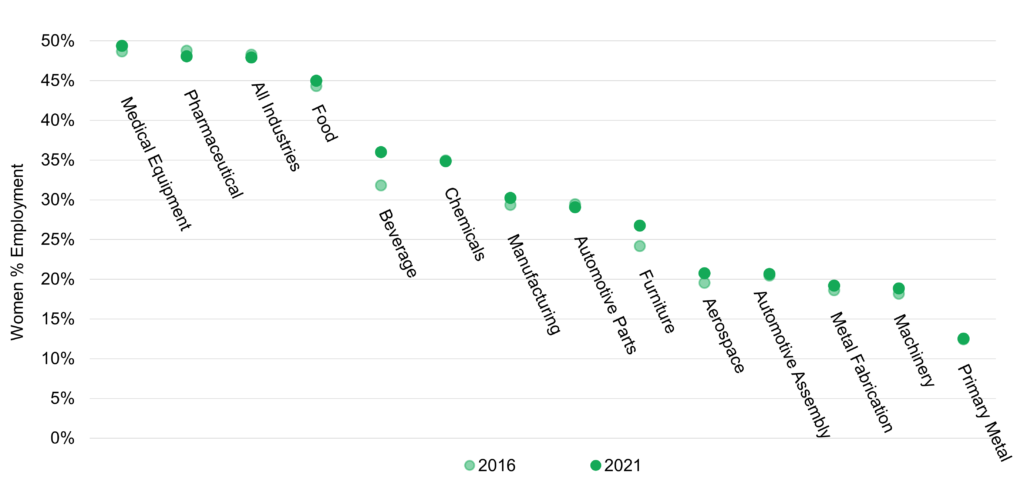The importance of manufacturing to Ontario’s economy and communities cannot be overstated. Despite their vital role in the provincial economy, however, manufacturers across the province face tight labour markets and struggle to recruit and retain employees. These challenges are exacerbated by the relatively low number of women employed in manufacturing.
In Ontario, women represent approximately half the population and half the workforce. The province’s manufacturers, regardless of industry or size, need to engage with the best and brightest in order to succeed in an increasingly competitive economy. By this logic, at least half of Ontario’s best and brightest are women. Yet, according to the most recent census, only 30 per cent of manufacturing employees are women. (Talk about leaving money on the table).
The good news: this represents an increase of 0.86 of a percentage point when compared to the previous (2016) census. The bad news: this increase is, at the end of the day, insignificant. At this rate, Ontario’s manufacturing sector will not reach gender parity until sometime around 2131 (not a typo).
Our more detailed analysis recognizes that manufacturing is not monolithic, and that many industry segments are distinct. Figure 1 illustrates the inverse relationship between total compensation (including benefits and pension) and the proportion of women employees in most industry segments, a persistent feature of manufacturing first identified in a 2021 Trillium Network report.
Figure 1 – Women as a % of the Workforce and Average Annual Compensation, Select Industries

Sources: Statistics Canada Tables 98-10-0448-01, 98-400-X2016290, and 36-10-0489-05.
The highest-paying industries, including vehicle assembly, aerospace, and primary metal (i.e. steel mills), employ far fewer women as a proportion of their total workforce than do such lower-paying industries as clothing and food processing. Perhaps the only true bright spot is the pharmaceutical product manufacturing industry, where earnings are high and women make up nearly half the workforce.
Figure 2 compares women as a proportion of the manufacturing workforce in several industry segments in 2016 and 2021. For the most part, there was little change. The most noticeable increase was in the beverage industry, where production shifted away from large and well-capitalized facilities toward small craft-based producers. There were also small increases in the relatively low-paying furniture industry and in the very well-paying aerospace industry.
Figure 2 – Women as a % of the Workforce, Select Industries, 2016 vs. 2021

Sources: Statistics Canada Tables 98-10-0448-01 and 98-400-X2016290
From these data we make three observations, some of which are based on recent research. First, the occupational mix in any given industry plays an important role in determining gender diversity. Industries with relatively high proportions of employees trained in the sciences (e.g. pharmaceutical products) tend to employ relatively high proportions of women. Conversely, industries with relatively high proportions of tradespersons (e.g. metalworking and machining) tend to employ few women. (For those less familiar with the subject material, the number of female tradespersons working in Ontario manufacturing is negligible). Second, industries with an older and long-tenured workforce (e.g. vehicle assembly, primary metal), tend to employ higher proportions of men. There is a notion, however, that there is opportunity for change as long-tenured employees near retirement age. Third, one consequence of tight labour markets is that employment opportunities are abundant. Women (and people in general) will gravitate toward employers, occupations, and industries where they are valued. Early evidence suggests that these industries include agriculture and public administration (i.e. government).
If the relatively low engagement of women by manufacturers is indeed a problem, what can we do about it? We offer three suggestions.
- Take stock of what works and, importantly, what doesn’t. Our foremost concern here is related to the trades. There are a number of programs designed to encourage women, newcomers to Canada, and younger persons to consider careers in the trades. These programs pay lip service to manufacturing, but are generally designed to encourage people to consider careers in other sectors, such as construction and utilities. Moreover, there is no evidence that these programs have addressed any underlying causes that discourage women from considering careers in the trades. If we truly want to encourage women to consider careers in the manufacturing trades, we will need to approach the issue in a fundamentally different way. We see more value in programs that encourage women to consider careers in STEM occupations, many of which are led by or affiliated with Ontario’s world-class universities. Manufacturing executives and leaders tend to emerge from those with STEM backgrounds. More women in STEM occupations in manufacturing could potentially result in more women in leadership positions.
- Learn from companies that have made real and measurable progress. Our previous work documents the successes of companies such as Honda of Canada Mfg., Sanofi Pasteur, and Muskoka Brewery. General Motors of Canada has made progress at its Oshawa assembly plant, although its path to success was not particularly straightforward. We hear good things about Toronto-area aerospace manufacturers, large and small, notably MDA and Kepler Communications. We would love to learn more about how Ontario-based manufacturers in high-paying industries have made real and measurable progress when it comes to gender diversity.
- Capitalize on new investments in aerospace and the EV supply chain. Four large new facilities are scheduled to open in Ontario in the next year or two. These include:
- Bombardier’s aircraft production facility in Mississauga, which will employ 3,000 people;
- NextStar Energy’s EV battery plant in Windsor, which will employ 2,500 people;
- Umicore’s EV battery materials plant in Loyalist Township near Kingston, which will employ more than 1,000 people; and
- MDA’s global HQ and Centre of Excellence for Space Robotics in Brampton, which will employ more than 700 people.
Each of these new facilities is likely to receive government incentives. While the employment covenants associated with these investments are unlikely to be made public, they represent an opportunity to integrate gender diversity goals and broader ESG principles directly into epochal manufacturing investments that have not been witnessed in Ontario for decades.
Key Takeaways
- Engaging more women, and other under-represented demographic groups, is important to the long-term competitiveness of Ontario’s advanced manufacturing ecosystem.
- The occupational composition of an industry is closely related to the proportion of women working in that industry.
- There is much to be learned from manufacturers that pay well and have made intentional and measurable progress related to gender diversity, although such examples are few and far between.